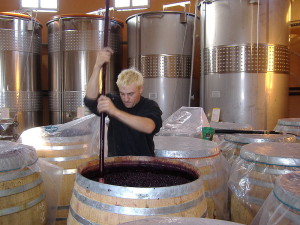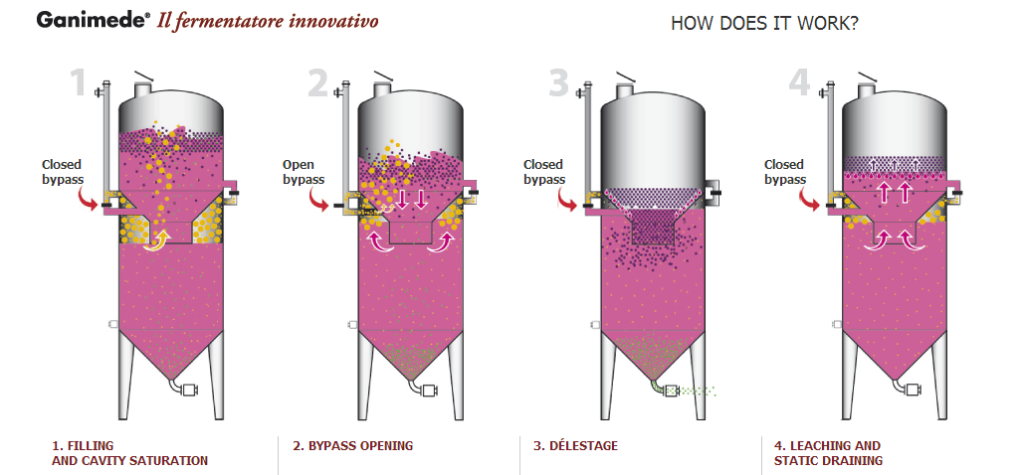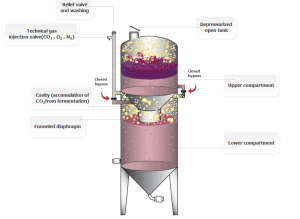Part of the traditional process of red winemaking involves a maceration step, allowing the skins and seeds of the grapes to “steep” together for a certain period of time in order to extract the desired compounds that make up a quality wine. If one just leaves the skins and seeds sitting in the wine and leave it alone completely, eventually all the skins will rise to the top, forming a hard, virtually impenetrable cap resulting in poor extraction, and poor yeast performance, just to name a couple examples.
What winemakers and cellar workers have to do to improve performance and optimize phenolic and other compound extraction from the skins and seeds to the wine, they must “stir up” the solution, punching down the skin/seed cap at the top and reintegrating it into the wine. More extraction can occur, and then over time, the skins and seeds float back up to the top. You can see then, this becomes a cycle of punching
down and mixing, which depending upon how it is done can be time consuming and relatively difficult.
One of the more recent technological advances to help improve maceration techniques is the Ganimede fermentation method, and is the focus of the study presented to you today. Very briefly, the Ganimede fermenter consists of an inverted cone inside and toward the top of the device, allowing carbon dioxide to become trapped in the space between the cone and the side of the fermenter. As fermentation goes along, the CO2 continues to build up until the pressure is high enough to be released through an external pipe that connects back to the top of the fermenter, effectively pushing the skin and seed cap back down into the must. This is apparently a much more gentle method than physically punching down the cap with more traditional materials and equipment.
How does the Ganimede fermentation method compare with traditional fermentation and maceration methods in terms of the phenolic profile of finished wines before and after aging? Is the Ganimede fermenter as successful as traditional maceration in extracting phenolic compounds from the must? How does a wine fermented in a Ganimede fermenter fare with aging compared with traditional methods?
As many of my readers know, phenolic compounds in wine play a major role in the overall quality and ageability of a wine. From color to aroma and from astringency to body, phenolic compounds act both independently and in concert with one another to produce a unique wine with specific characteristics that set it apart from all other wines.
The article presented to you today aimed to compare traditional and Ganimede fermentation methods on the phenolic profile of Cabernet Sauvignon wines, also taking a look at how aging of these wines differed (or not!) depending upon which fermentation method was employed.
Methods
Cabernet Sauvignon grapes were harvested at maturity from a vineyard in Yuma, Ningxia province in China (2009 vintage). After sorting and destemming, the grapes were separated into four different groups: 2 groups for the traditional winemaking treatment, and 2 groups for the Ganimede fermentation treatment.
For the traditional winemaking group, alcoholic fermentation was completed in a stainless steel tank, with maceration occurring simultaneously using pump over mechanisms.
After fermentation, both groups went through malolactic fermentation and later bottling.
The following compounds were measured and analyzed for all wine samples: total phenolics, color intensity, anthocyanins, flavan-3-ols, flavonols, hydroxybenzoic acids, hydroxycinnamic acids, and stilbenes. Specific compounds included (+)-catechin, quercetin, gallic acid, caffeic acid, and resveratrol.
Results
Before Aging:
- 22 anthocyanins were detected in wines fermented using traditional methods, while 23 anthocyanins were detected in wines fermented using the Ganimede fermentation method.
- The extra anthocyanin found in the Ganimede wine was peonidin-3-O-(6-O-acetyl)-glucoside-4-vinylphenol.
- In general, the anthocyanin profile for both traditional and Ganimede wines were very similar.
- Anthocyanin levels in Ganimede wines were significantly higher than wines made using traditional fermentation methods.
- Monomeric anthocyanin levels were significantly higher in Ganimede wines compared with traditional wines.
- The anthocyanins malvidin-3-O-glucoside, petunidin-3-O-glucoside, dephinidin-3-O-glucoside, and peonidin-3-O-glucoside were significantly higher in Ganimede wines, resulting in a deeper red/purple color that is often considered desirable among consumers.
- The authors indicate that these results suggest the Ganimede method may be more appropriate for younger wines, since anthocyanin levels were higher in these wines and it’s generally faster and less labor-intensive to perform Ganimede fermentation compared with traditional fermentation.
- Wines fermented using the Ganimede fermentation method has significantly higher levels of acylatedanthocyanins compared with wines fermented in traditional methods.
- There were no differences between the two fermentation methods in terms of anthocyanin polymer content.
- 38 non-anthocyanins were detected in the wines.
- Flavan-3-ols and flavonols were the dominant non-anthocyanins present.
- Total flavan-3-ols were very similar between Ganimede wines and traditional wines.
- (+)-catechin and (-)-epicatechin were significantly higher in wines made using the Ganimede fermentation method compared with wines made using traditional methods.
- There was no difference in hydroxybenzoic acid levels between the two groups.
- Hydroxycinnamic acid was significantly higher in wines made in traditional fermentation methods compared with the wines made using Ganimede fermentation methods.
- Both trans– and cis-resveratrol was detected in both wines, while resveratrol-3-O-glucoside was only detected in the wine made using traditional fermentation method.
- Stilbenes levels were significantly higher in wines made using traditional fermentation method compared with wines made using the Ganimede fermentation method.
- The total polyphenol index of both wines was statistically similar (though technically the value was slightly higher in the traditional wines).
- Color intensity was significantly higher in wines made using the Ganimede fermenter compared with wines made using traditional methods.
After 2 Years of Aging:
- After 2 years of aging, 15 anthocyanins were detected in wines made using traditional fermentation techniques, while 17 anthocyanins were detected in wines made using the Ganimede fermentation method.
- Total anthocyanin levels decreased with aging by 75% for wines made using traditional methods, and by 81% for wines made using the Ganimede fermenter, resulting in about 10% more anthocyanins in the traditional wines.
- The ratio of pyranoanthocyanins and polymeric anthocyanins increased with aging in both groups, in addition to a decrease in monomeric anthocyanins (a benefit to color stability).
- All non-acylated anthocyanins decreased in both wines, though they were significantly lower in wines made using the Ganimede fermentation method compared with wines made using traditional methods.
- There were no differences in acylated anthocyanins between the two groups.
- Pyranoanthocyanin levels were significantly higher in wines made using the Ganimede fermentation method compared with traditional methods.
- Peonidin-3-O-glucoside-4-vinylphenol and malvidin-3-O-glucoside-4-vinylguaiacol were only detected in the aged Ganimede wines, resulting in a more yellowed color than wines made in traditional fermentation methods.
- Polymeric anthocyanins were statistically equal between the two groups.
- Total flavan-3-ols were similar between the two wines.
- After aging, caffeic acid was significantly higher in wines made using the Ganimede fermentation method compared with wines made using traditional fermentation methods.
- The total polyphenol index of both wines was significantly higher in wines made using traditional fermentation methods compared with those made using the Ganimede fermenter.
- Color intensity of the Ganimede wines significantly decreased with aging, though the final levels were statistically similar between the Ganimede wines and the traditional wines.
Conclusions
Overall, according to the researchers, the results of this study indicate that while phenolic content of both wines were generally similar to one another, there were a few small differences that were significant enough to make marked changes in the finished wines. Specifically, wines made using the Ganimede method had greater levels of anthocyanins and other polyphenols when the wine was young, showing richer coloring and overall improvement in the phenolic characteristics of the finished wines. On the other hand, as they aged, the wines made using the Ganimede method lost a significant amount of anthocyanins and other polyphenols over time, resulting in an aged wine that was much less stable (at least in terms of color) than the aged wines made using more traditional methods.
If the results of this study are indicative of true, repeatable events, then it would seem to suggest that the
Ganimede fermentation method may be the better choice if the goal is to make young “drink now” wines, while if the goal is to produce a wine capable of aging, traditional fermentation and maceration techniques seem to be much more appropriate.
Overall, I think this study did a nice job, though I would be hesitant to say that these results are repeatable for all wines. First, the only grapes used in this study to make the experimental wines were Cabernet Sauvignon. Perhaps these are the results one gets for Cabernet Sauvignon, but do we see the same behavior when we try a Syrah, a Sangiovese, or maybe a Merlot? Due to phenolic differences between the grape varieties, I would like to see the same study repeated using multiple grape varieties in order to see how this Ganimede fermentation method affects musts other than Cabernet Sauvignon.
The other problem with issuing blanket statement on which fermentation method is better is related to the location in which the grapes were harvested and the wines were made. If you recall, these grapes were grown, harvest, and processed in China. What effect does Chinese terroir have on different grapes? (Here’s an article looking at the influence of terroir on Cabernet Sauvignon in China). How does this compare with grapes grown in France, the US, Australia, or any other grape growing region? Maybe using the Ganimede method is better for young “drink now” Chinese-made wines, but perhaps the results would be opposite if grapes from other winemaking regions were used? Before I would say “the Ganimede fermentation method is better for young wines”, I would need to see results from multiple grape varieties grown in multiple grape growing regions.
What about you all? Do you have any experience with Ganimede fermenters? What were your results? Please feel free to share any and all comments or questions you all might have related to this research/topic.




7 comments for “The Ganimede Fermentation Method: How Does It Stack Up to a More Traditional Approach?”